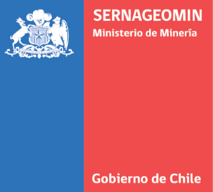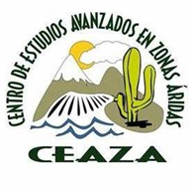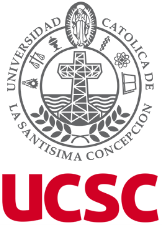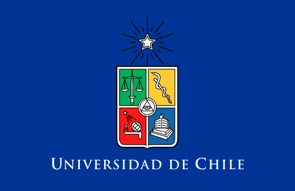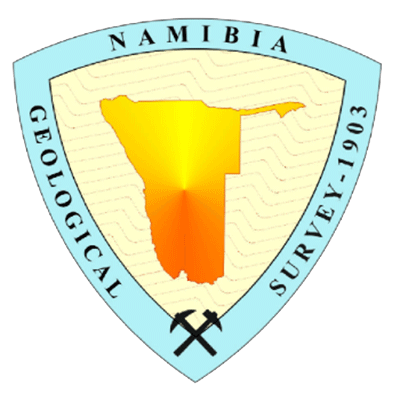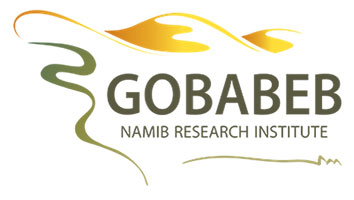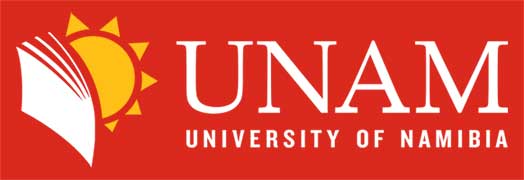Transport and deposition: Formation of alluvial fans and their geo-bio-archive function under hyperaridity – Integrating empiricism and landscape evolution modelling
Research areas: Physical Geography, Geomorphology, Landscape Evolution
Principal investigators: Prof. Dr. Frank Lehmkuhl, Dr. Janek Walk, Dr. Dominik Brill, Prof. Dr. Jean Braun
Project Info: Phase 3
Due to the direct coupling of alluvial fans (AF) to the source area, they present quintessential depositional features and preserve responses of the sediment routing systems to palaeoclimatic variability, tectonic activity and base-level changes in their architecture and stratigraphy. However, the impact of autogenic controls governing the AF internal dynamics make it challenging to decipher these allogenic environmental controls. AF are widespread in the Atacama Desert from its arid margins to its hyperarid core and, thus, provide great potential to link and compare these morphodynamic systems with other existing regional palaeoenvironmental archives – of which many have been and are planned to be further investigated within the CRC 1211. Informed by the results of the previous phases, the following overarching research questions will be pursued:
- How is the impact of autogenic and environmental (allogenic) controls reflected in the variability of AF structure under transport- versus sediment-supply (under-capacity) limitation – and are consequently governing AF ecological habitat function in the Atacama Desert?
- How does fan evolution under (hyper)aridity affect the propagation of climatic, biotic and geologic source-area signals and their preservation in fan stratigraphy – and thus impact the potential of AF as Quaternary and Neogene palaeoenvironmental archives for the Atacama Desert?
Braun (2022) has contrasted two fundamental approaches for modelling fan evolution (transport-limitation versus under-capacity), that are characterized by different internal fan structures and building times needed to reach a steady state. A synthesis of empirical data on AF and source-area morphology, stratigraphy and timing in the Atacama Desert assessed during the first and second phases of the CRC 1211 (Bartz et al., 2020a, 2020b; Walk et al., 2019, 2020, 2022, 2023), complemented by well-directed analysis of additional AF at strategic locations, will be used to parametrize and validate the different physics-based numerical approaches. This will provide critical insights on (i) which approach is best suited for replicating the evolution of AF under different climatic and tectonic conditions and (ii) a better understanding of the AF environment and thus a basis for the interpretation of fan (morpho)stratigraphic records. The approach will be applied along a longitudinal environmental gradient across the Atacama Desert extended to the arid Altiplano. This aims at deciphering the impacts of different allogenic controls on fan evolution from autogenic ones under real conditions – a challenging objective that is hard to achieve exclusively by modelling or empiricism. A better understanding of the geomorphic fan evolution will further allow to study in a close bio-geo-collaboration their potential as “habitats and pathways of life” under water limitation. The following working hypotheses (W.H.) are formulated:
- While the impacts of autogenic controls are reflected in the variability in AF structure on small spatiotemporal scales, environmental (allogenic) controls affect the meso-scale architecture of AF; also under hyperaridity, climatic fluctuations present the major allogenic driver on the meso-scale.
- Transport- versus sediment-supply (under-capacity) limitation governs the AF evolution before reaching steady-state; under the arid to hyperarid climate of the Atacama Desert, transport limitation dominates and is reflected in the fan architecture.
- With advancing evolution and as a function of size, propagation of climatic, biotic and geologic source-area signals become more shredded and their preservation potential in the fan stratigraphy decreases.
- AF constitute favourable habitats for soil organisms and plants in the Atacama Desert and their potential as “habitats and pathways of life” is affected by the type of fan evolution towards steady-state, size and stratigraphy – besides further dependence on the palaeoclimatic circumstances and hydrological catchment-wide connectivity.
Phase 2
Transport and deposition: Deciphering the late Neogene and Quaternary evolution of alluvial fans along the coastal ranges in the Atacama and Namib deserts
Research areas: Physical Geography
Principal investigators: Prof. Dr. Frank Lehmkuhl, Dr. Dominik Brill
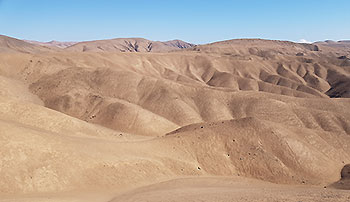 |
|
|
Dissection of the Coastal Cordillera in the hyperarid Atacama Desert. |
After a successful first phase of the project (see below), also subproject C2 entered the second phase in July 2020. As an internationally collaborating team, we will work on new interdisciplinary questions concerning the Quaternary to Neogene landscape development of the coastal deserts in northern Chile (Atacama Desert) and northwestern Namibia (Skeleton Coast) as well as the interaction between fluvial, aeolian, and marine processes there. The main geo-archive to be studied will remain alluvial fans, which are sedimentary landforms typical along mountain fronts and principally ideal fluvial archives due to the direct coupling to their source area.
Research objectives
On the one hand, we will investigate the transport and sedimentation dynamics under hyperaridity from the coast of the Atacama into the interior Coastal Cordillera. On the other hand, an intercontinental comparison between the external control of alluvial fan morphodynamics at the active continental margin of N Chile and the passive continental margin of NW Namibia will be conducted. In close cooperation with the other subprojects in the CRC1211, we will also investigate the influence of biota on sediment supply in the Atacama Desert. A further research question deals with the intensity of post-depositional processes, such as the effects of weathering and soil formation, and their use for morphostratigraphic characterization.
Methods
Within the four years, several field campaigns are planned to the Coastal Cordillera of the Atacama Desert as well as to the Skeleton Coast. We apply proven methods from the first phase together with a portfolio of new methods. Hydromorphometric, climatic, and geological spatial as well as functional trend analyses in NW Namibia will be compared with those from the Atacama Desert. In addition, we will achieve a better understanding of heavy rainfall events on fluvial morphodynamics in hyperarid deserts by a combination of modern remote sensing and local in-situ measurements. Furthermore, we will constrain the palaeo-activity of alluvial fans chronologically by a combination of cosmogenic nuclide, luminescence, radiocarbon, and palaeomagnetic dating as well as, if applicable, tephrochronology. Eventually, the composition of the individual results will provide new insights into the geomorphological processes and landscape genesis of hyperarid regions.
Cooperations and partners
- Dr. Tobias Ullmann – Institute of Geography and Geology, Julius-Maximilians University Würzburg
- Anna Nguno – Geological Survey of Namibia, Ministry of Mines and Energy, Windhoek, Namibia
- Andrés Quezada – Servicio Nacional de Geología y Minería, Santiago, Chile
Phase 1
Transport and deposition: Deciphering the evolution of the alluvial fans between 21°S and 25°S – the interplay between climatic and tectonic control
Research areas: Physical Geography
Principal investigators: Prof. Dr. Frank Lehmkuhl, Dr. Dominik Brill
In the first phase, the project focused on the alluvial fans along the coast of the hyperarid Atacama Desert. There, alluvial fans emerge from the steep Coastal Cordillera and spread over a narrow plain to the Pacific Ocean. By studying their distribution, surface morphology, architecture, timing, and drainage basin characteristics along a S-N gradient of increasing aridity, we aimed at deciphering the processes involved in their morphogenesis and the different impacts of climatic and geologic controls on alluvial fan evolution.
Methods
For this purpose, detailed remote sensing-based geomorphological mapping was combined with stratigraphic investigations of the fan deposits, as well as the establishment of chronologies using cosmogenic nuclide, luminescence, and electron spin resonance dating. We conducted, in total, three field campaigns between March 2017 and September 2018.
Conclusion
The first phase of the project expired in June 2020. During the four years, we successfully obtained and published new insights into the morphology, primary processes, and Late Pleistocene evolution of the coastal alluvial fans along the latitudinal climate gradient, the associated palaeoenvironmental conditions, and methodological advances in luminescence and electron spin resonance dating.
Former members
- Prof. Dr. Helmut Brückner, Principal Investigator – University of Cologne, Institute of Geography
- Dr. Melanie Bartz, Scientist – University of Cologne, Institute of Geography
Cooperations and partners
- Dr. Jean-Pierre Francois – Universidad de Playa Ancha, Valparaíso
- Dr. Marco Cisternas Vega – Pontificia Universidad Católica de Valparaíso
- Dr. Paulina Vásquez – Servicio Nacional de Geología y Minería, Santiago, Chile
- Dr. Fernando A. Sepúlveda – Servicio Nacional de Geología y Minería, Santiago, Chile
Publications
Project C2 - Publications
Articles
Sun, X., Amelung, W., Klumpp, E., Walk, J., Mörchen, R., Böhm, C., Moradi, G., May, M., Tamburini, F., Wang, Y., Bol, R., 2023.
Fog controls biological cycling of soil phosphorus in the Coastal Cordillera of the Atacama Desert.
Global Change Biology. 30:e17068 (1), 1 - 19. DOI: 10.1111/gcb.17068.
Sun, X., May, M., Amelung, W., Tang, N., Brill, D., Arenas-Díaz, F., Contreras, D., Fuentes, B., Bol, R., Klumpp, E., 2023.
Water-dispersible colloids distribution along an alluvial fan transect in hyper-arid Atacama Desert.
Geoderma. 438 (116650), 1 - 13. DOI: 10.1016/j.geoderma.2023.116650.
Walk, J., Schulte, P., Bartz, M., Binnie, A., Kehl, M., Mörchen, R., Sun, X., Stauch, G., Tittmann, C., Bol, R., Brückner, H., Lehmkuhl, F., 2023.
Pedogenesis at the coastal arid-hyperarid transition deduced from a Late Quaternary chronosequence at Paposo, Atacama Desert.
Catena. 228 (2023) (107171), 1 - 21. DOI: 10.1016/j.catena.2023.107171.
Walk, J., Bartz, M., Stauch, G., Binnie, A., Brückner, H., Lehmkuhl, F., 2021.
Weathering under coastal hyperaridity – Late Quaternary development of spectral, textural, and gravelometric alluvial fan surface characteristics.
Quaternary Science Reviews. 277 (2022) (107339), 1 - 27. DOI: 10.1016/j.quascirev.2021.107339.
Bartz, M., Walk, J., Binnie, S., Brill, D., Stauch, G., Lehmkuhl, F., Hoffmeister, D., Brückner, H., 2020.
Late Pleistocene alluvial fan evolution along the coastal Atacama Desert (N Chile).
Global and Planetary Change. 190 (103091), 1 - 20. DOI: 10.1016/j.gloplacha.2019.103091.
Bartz, M., Duval, M., Brill, D., Zander, A., King, G., Rhein, A., Walk, J., Stauch, G., Lehmkuhl, F., Brückner, H., 2020.
Testing the potential of K-feldspar pIR-IRSL and quartz ESR for dating coastal alluvial fan complexes in arid environments.
Quaternary International. 556, 124 - 143. DOI: 10.1016/j.quaint.2020.03.037.
Walk, J., Stauch, G., Bartz, M., Brückner, H., Lehmkuhl, F., 2019.
Geomorphology of the coastal alluvial fan complex Guanillos, northern Chile.
Journal of Maps. 15 (2), 436 - 447. DOI: 10.1080/17445647.2019.1611499.
Walk, J., Stauch, G., Reyers, M., Vásquez, P., Sepúlveda, F., Bartz, M., Hoffmeister, D., Brückner, H., Lehmkuhl, F., 2019.
Gradients in climate, geology, and topography affecting coastal alluvial fan morphodynamics in hyperarid regions – The Atacama perspective.
Global and Planetary Change. 185 (102994), 1 - 24. DOI: 10.1016/j.gloplacha.2019.102994.
Event Papers
Walk, J., 2025.
Expansion of the Late Quaternary morphochronology of Atacama’s coastal alluvial fans (northern Chile) by Schmidt hammer exposure-age dating.
Proc. of EGU General Assembly 2025, EGU25 (4535), April 27 - May 02, 2025, Vienna, Austria, 1 - 2. DOI: 10.5194/egusphere-egu25-4535.
Walk, J., Mohren, J., Binnie, A., Brill, D., Brückner, H., Schaubert, V., Quezada, A., Lehmkuhl, F., 2024.
Assessing the last “large scale fluvial modification” across the hyperarid Atacama Desert, northern Chile.
Proc. of EGU General Assembly 2024, EGU24 (11939), April 14 - 19, 2024, Vienna, Austria, 1 - 1. DOI: 10.5194/egusphere-egu24-11939.
Walk, J., Boemke, B., Ullmann, T., 2023.
Spatial flood frequency analysis of ephemeral rivers in Northwest Namibia based on cloud computing of Landsat time series.
Proc. of EGU General Assembly 2023, EGU23 (12947), April 23 - 28, 2023, Vienna, Austria, 1 - 1. DOI: https://doi.org/10.5194/egusphere-egu23-12947.
Walk, J., Tittmann, C., Schulte, P., Mörchen, R., Sun, X., Bartz, M., Binnie, S., Stauch, G., Bol, R., Brückner, H., Lehmkuhl, F., 2022.
Assessing soil formation under coastal hyperaridity since the Mid-Pleistocene using a chronosequence dated by in situ cosmogenic 10Be at Paposo, Atacama Desert (N Chile).
Proc. of EGU General Assembly 2022, EGU22 (7889), May 23 - 27, 2022, Vienna, Austria, 1 - 2. DOI: https://doi.org/10.5194/egusphere-egu22-7889.
Walk, J., Bartz, M., Stauch, G., Reyers, M., Binnie, S., Brill, D., Vásquez, P., Sepúlveda, F., Hoffmeister, D., Brückner, H., Lehmkuhl, F., 2020.
Coupled controls of climate, geology, and biota on late Pleistocene alluvial fan morphodynamics along the coast of the hyperarid Atacama Desert.
Geophysical Research Abstracts. Proc. of EGU2020: Sharing Geoscience Online, 22 (EGU2020-7461), May 04 - 08, 2020, Vienna, Austria (online), 1 - 2.
Bartz, M., Duval, M., Walk, J., Brill, D., Zander, A., King, G., Stauch, G., Lehmkuhl, F., Brückner, H., 2019.
Late Quaternary alluvial fan evolution along the coast of the hyper-arid Atacama Desert - the interplay between climatic and tectonic control.
Geophysical Research Abstracts. Proc. of EGU General Assembly 2019, 21 (EGU2019-10788), April 07 - 12, 2019, Vienna, Austria, 1 - 1.
Walk, J., Stauch, G., Reyers, M., Bartz, M., Hoffmeister, D., Brückner, H., Lehmkuhl, F., 2019.
Alluvial fan morphodynamics along the coastal Atacama Desert – geomorphometric, geologic, and climatic perspectives.
Geophysical Research Abstracts. Proc. of EGU General Assembly 2019, 21 (EGU2019-7543), April 07 - 12, 2019, Vienna, Austria, 1 - 1.
Data
Project C2 - Research Data
Walk, J., Mohren, J., Krieger, J., 2023.
Alluvial fans mapped along the Skeleton Coast of Namibia.
CRC1211 Database (CRC1211DB).
Walk, J., Schulte, P., Bartz, M., Binnie, A., Kehl, M., Mörchen, R., Sun, X., Stauch, G., Tittmann, C., Bol, R., Brückner, H., Lehmkuhl, F., 2023.
Supplementary Data for Walk et al. (2023) "Pedogenesis at the coastal arid-hyperarid transition deduced from a Late Quaternary chronosequence at Paposo, Atacama Desert".
Elsevier B.V..
Walk, J., Schulte, P., Bartz, M., Binnie, A., Kehl, M., Mörchen, R., Sun, X., Stauch, G., Tittmann, C., Bol, R., Brückner, H., Lehmkuhl, F., 2022.
Soil physicochemical parameters along a chronosequence at the coastal alluvial fan Paposo, Atacama Desert.
CRC1211 Database (CRC1211DB). DOI: 10.5880/CRC1211DB.56.
Walk, J., Schulte, P., Bartz, M., Binnie, A., Kehl, M., Mörchen, R., Sun, X., Stauch, G., Tittmann, C., Bol, R., Brückner, H., Lehmkuhl, F., 2022.
Grain size distributions and parameters of soils along a chronosequence at the coastal alluvial fan Paposo, Atacama Desert.
CRC1211 Database (CRC1211DB). DOI: 10.5880/CRC1211DB.55.
Walk, J., 2022.
UAS-based very high resolution digital elevation model and orthomosaic of the coastal alluvial fan Paposo, Atacama Desert.
CRC1211 Database (CRC1211DB).
Walk, J., 2022.
UAS-based very high resolution digital elevation model and orthomosaic of the lower Pica Valley, Atacama Desert.
CRC1211 Database (CRC1211DB).
Walk, J., Bartz, M., Binnie, A., Kehl, M., Mörchen, R., Schulte, P., Sun, X., Stauch, G., Tittmann, C., Bol, R., Brückner, H., Lehmkuhl, F., 2022.
Terrestrial cosmogenic nuclide (10Be) concentrations for Guanillos (GUA) and Paposo (PAP).
CRC1211 Database (CRC1211DB).
Walk, J., Krieger, J., Brill, D., Lehmkuhl, F., 2022.
Compilation of regional geological maps 1:250000 (original geodata and compiled shapefiles) of Northwest Namibia.
CRC1211 Database (CRC1211DB).
Walk, J., Weise, J., Brückner, H., Lehmkuhl, F., 2021.
Compilation of regional geological maps (original maps and compiled shapefiles) of the western Atacama Desert (20°S–25.5°S, N Chile).
CRC1211 Database (CRC1211DB).
Walk, J., 2021.
High-resolution WorldView-2 stereo satellite imagery and DEM (Messum – East, NW Namibia).
CRC1211 Database (CRC1211DB).
Walk, J., 2021.
High-resolution WorldView-3 stereo satellite imagery and DEM (Messum – West, NW Namibia).
CRC1211 Database (CRC1211DB).
Walk, J., 2021.
High-resolution WorldView-2 stereo satellite imagery and DEM (Sechomib – East, NW Namibia).
CRC1211 Database (CRC1211DB).
Walk, J., 2021.
High-resolution WorldView-3 stereo satellite imagery and DEM (Sechomib – West, NW Namibia).
CRC1211 Database (CRC1211DB).
Walk, J., Bartz, M., Stauch, G., Binnie, A., Brückner, H., Lehmkuhl, F., 2021.
Supplementary Data for Walk et al. (2022) "Weathering under coastal hyperaridity – Late Quaternary development of spectral, textural, and gravelometric alluvial fan surface characteristics".
Elsevier Ltd..
Walk, J., Stauch, G., Reyers, M., Vásquez, P., Sepúlveda, F., Bartz, M., Hoffmeister, D., Brückner, H., Lehmkuhl, F., 2021.
Supplementary Data for Walk et al. (2020) "Gradients in climate, geology, and topography affecting coastal alluvial fan morphodynamics in hyperarid regions – The Atacama perspective".
Elsevier B.V..
Walk, J., Bartz, M., Stauch, G., Brückner, H., Lehmkuhl, F., 2021.
UAS-based micro-scale surface texture for different generations of the coastal alluvial fan Guanillos, Atacama Desert.
CRC1211 Database (CRC1211DB). DOI: 10.5880/CRC1211DB.41.
Walk, J., Bartz, M., Stauch, G., Brückner, H., Lehmkuhl, F., 2021.
UAS-based very high resolution digital elevation models and orthomosaics of the coastal alluvial fan Guanillos, Atacama Desert.
CRC1211 Database (CRC1211DB). DOI: 10.5880/CRC1211DB.40.
Walk, J., Bartz, M., Stauch, G., Brückner, H., Lehmkuhl, F., 2021.
Pleiades-1 spectral iron oxide ratios for different surface generations of the coastal alluvial fan Guanillos, Atacama Desert.
CRC1211 Database (CRC1211DB). DOI: 10.5880/CRC1211DB.38.
Walk, J., Bartz, M., Stauch, G., Brückner, H., Lehmkuhl, F., 2021.
Ground control for UAS surveys of the coastal alluvial fan Guanillos, Atacama Desert.
CRC1211 Database (CRC1211DB).
Walk, J., Bartz, M., Stauch, G., Brückner, H., Lehmkuhl, F., 2021.
UAS-based surface gravelometry for different generations of the coastal alluvial fan Guanillos, Atacama Desert.
CRC1211 Database (CRC1211DB). DOI: 10.5880/CRC1211DB.39.
Walk, J., Schulte, P., Bartz, M., Stauch, G., Brückner, H., Lehmkuhl, F., 2019.
C02 - X-ray fluorescence (XRF) spectroscopy data.
CRC1211 Database (CRC1211DB).
Bartz, M., Walk, J., Binnie, S., Brill, D., Stauch, G., Lehmkuhl, F., Hoffmeister, D., Brückner, H., 2019.
Terrestrial cosmogenic nuclide (10Be) concentrations for Virgen del Camino (VIR) and Caleta Botija (BOT).
CRC1211 Database (CRC1211DB).
Walk, J., Bartz, M., Rethemeyer, J., Stauch, G., Brückner, H., Lehmkuhl, F., 2019.
C02 - Radiocarbon data.
CRC1211 Database (CRC1211DB).
Walk, J., Schulte, P., Bartz, M., Stauch, G., Brückner, H., Lehmkuhl, F., 2019.
C02 - Grain size data.
CRC1211 Database (CRC1211DB).
Walk, J., Mörchen, R., Amelung, W., Lehmkuhl, F., 2019.
Paposo soil samples - carbon analysis.
CRC1211 Database (CRC1211DB).
Walk, J., Bartz, M., Stauch, G., Brückner, H., Lehmkuhl, F., 2019.
C02 - Coastal alluvial fan catchments and streams (geodata).
CRC1211 Database (CRC1211DB).
Walk, J., Bartz, M., Stauch, G., Brückner, H., Lehmkuhl, F., 2019.
C02 - Coastal alluvial fans (geodata).
CRC1211 Database (CRC1211DB).
Walk, J., Bartz, M., Stauch, G., Brückner, H., Lehmkuhl, F., 2019.
C02 - Sample locations and types (geodata).
CRC1211 Database (CRC1211DB).
Walk, J., Stauch, G., Reyers, M., Bartz, M., Brückner, H., Lehmkuhl, F., 2019.
Frequency analysis of WRF extreme precipitation events 10 km resolution Atacama.
CRC1211 Database (CRC1211DB). DOI: 10.5880/CRC1211DB.24.















